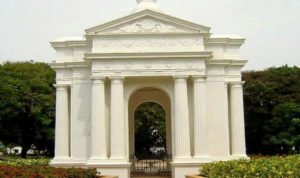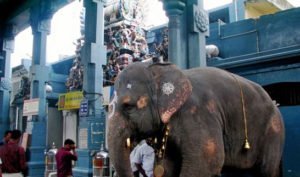Puducherry previously called Pondicherry and commonly known to as ‘Pondy’ was under the French jurisdiction until 1954 and some people here still speak French and English with French accents. Hotels, restaurants and ‘lifestyle’ shops sell a charming image of the French-subcontinental artistic, magnified by Gallic inventive types whose residence has, in turn, drew Indian artists and designers. Wide highways, seafront stroll, French building, stunning beaches and places of religious significance make Pondicherry a stop worthy of being visited.
Pondicherry Temples
Park Monument (Aayi Mandapam)
Another tourist places in Pondicherry Park Monument is Park Monument. It is an attractive, alluring destination that is located in the picturesque area of Government Park. Built during the period of Napoleon-III during the 16th century, this is a place that will transport you to the era gone by.
Currently, it is referred to by the name of Aayi, who was once a renowned courtesan. If the local stories are to be believed, Aayi destroyed her home and made a water tank instead of it. The king then believed that the candle lit house was a sacred place. It is widely believed that the tank was responsible for serving and bringing water from town to French engineers. This hassle free destination offers an insight into the lives and times of people in 16th century.
Manakula Vinayagar Temple
This Hindu temple, located in Pondicherry is dedicated to Lord Ganesha. It is widely considered a popular pilgrimage site. The temple and its antiquity reminds one of how Indian culture and heritage didn’t wither away even after years of colonization. During Dupleix’s tenure, several attempts were made to destroy the temple, but Hindu populations always managed to protect it through protests and threat of Maratha invasion.
Revered for its beauty and structure, the temple came into existence even before French came to the country. Constructed before 1666 AD, this place of worship has different names and types of Lord Ganesha. Meaning ‘sand around pond’, several scholars have written about this temple.
This place is also known for a saint, Thollaikkathu Siddhar, who stood 6 feet tall and had a broad forehead with blissful eyes. He is said to have attained enlightenment from this temple and later sacrificed his body here. People bring in their new born children here for getting blessings.
The shrine is well-known for its golden chariot, which has been made through donations by different devotees. 7.5 kilograms of gold has been used for constructing this chariot, which was estimated around INR 35 lacs. The chariot was first run in a grand ceremony on 5th October 2003. Now, it runs once a year on Dusherra.
Sri Aurobindo Ashram
One of favoured tourist places in Pondicherry, Sri Aurobindo Ashram is where people come to seek spiritual harmony and enlightenment. It once served as a spiritual community and is known for being the abode of spiritual guru, Sri Aurobindo.
During the early half of 20th century, Aurobindo stayed here along with his few disciples and Mirra Alfassa, the mother of the ashram and his spiritual collaborator. Once he withdrew from public view, all the responsibilities of the place were handed over to the Sadhaks, his spiritual aspirants. The ashram is also responsible for founding the concept of peaceful co-existence in a township. Auroville, the township in Pondicherry is the direct product of the ideals and aims of this ashram.
The ashram can be visited from 8 in the morning to 12 noon, or from 2 in the afternoon to 6 in the evening. This place is popular for following the internal yoga concept, which seeks to bring a transformation in life. It also follows the existential rule of living, wherein people are motivated to find a meaning of their life and attain divine perfection.





